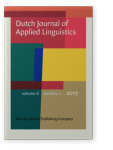Vol. 6:1 (2017) ► pp.21–40
Gesture use and its role for nativeness judgements
Despite the fact that gestures are seen as part of language, they are usually not included in studies of ultimate attainment and native-likeness in a second language. The aim of the present study is twofold: to give a description of the variation in gesture frequency, type and placement among different proficiency groups of Dutch learners of English, and to investigate the role that gestures play for determining nativeness of such learners. We compared gestures made by native and Dutch speakers of British English (BrE) and examined whether, and to what extent, native speakers of English use such gestures to judge nativeness. No clear differences were found between types, amounts and placements of gestures between the groups. Nor did the nativeness ratings of the three informant groups differ significantly. These results indicate that in contexts with two typologically and culturally similar languages gestures do not contribute to the perception of nativeness.
Article outline
- 1.Introduction
- 2.Gestures
- 2.1Gesture definition and categorization
- 2.2Cross-cultural and cross-linguistic gesture differences
- 2.3Research questions
- 3.Methodology
- 3.1Participants in the production task
- 3.2The production task: Elicitation and analysis
- 3.3Participants for the perception task
- 3.4The perception task
- 3.5Statistical analyses of the perception measures
- 4.Results
- 4.1Production task: Gesture description analysis
- 4.2Results from the perception task
- 5.Discussion
- 5.1Gesture production
- 5.2Gesture perception
- 6.Conclusion
- Notes
-
References
This article is currently available as a sample article.
